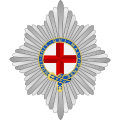This article has multiple issues. Please help improve it or discuss these issues on the talk page . (Learn how and when to remove these messages)
|


Campaign streamers are decorations attached to military flags to recognize particular achievements or events of a military unit or service. Attached to the headpiece of the assigned flag, the streamer often is an inscribed ribbon with the name and date denoting participation in a particular battle, military campaign, or theater of war; the ribbon's colors are chosen accordingly and frequently match an associated campaign medal or ribbon bar. They often are physical manifestations of battle honours, though this does not mean all streamers are battle honours (for example, gala or parade streamers not connected to a battle). They should not be confused with a tassel, which is usually purely decorative in nature.
Contents
- United States
- Background
- Usage
- Appearance
- 2023 Decision Regarding Confederate Battle Honors
- See also
- References
- External articles
The armed forces of Germany, the United States and others have engaged in awarding streamers. Historically Prussia, Austria-Hungary and the Soviet Union have also used streamers in this manner.




